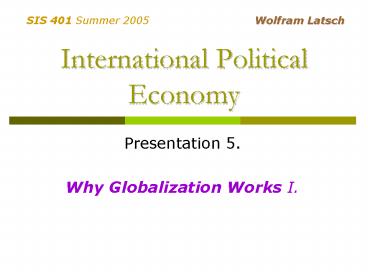International Political Economy - PowerPoint PPT Presentation
1 / 15
Title:
International Political Economy
Description:
'movement in the direction on greater integration' Greater 'integration of economic activities, ... Constitutionality, accountability (credibility, constraint) ... – PowerPoint PPT presentation
Number of Views:490
Avg rating:3.0/5.0
Title: International Political Economy
1
International Political Economy
SIS 401 Summer 2005
Wolfram Latsch
- Presentation 5.
- Why Globalization Works I.
2
What Liberal Globalization Means
- movement in the direction on greater
integration - Greater integration of economic activities, via
markets - Lowering of natural and man-made barriers to
international economic exchange - Greater reliance on market forces
3
Markets, Democracy and Peace
- Property and freedom
(political and economic liberties or rights,
political and economic control rights/property
rights) - The beneficent state
- Regulatory competition
(contestability) - Constitutionality, accountability
- (credibility, constraint)
- Moral reform
(commercial culture and guardian culture)
4
Markets, Democracy and Peace
- International relations
- Comparative advantage and absolute advantage
- Positive-sum interactions and zero-sum
interactions - Openness goods, services, technology, ideas
- Collectivism and liberalism
5
The Magic of the Market
- Rise of the market economy
- Property (incl. IPRs)
- Corporations
- Innovation
- Financial intermediation
6
Physician, Heal Thyself
- Death of central planning
- Whos the boss? Market or planner?
- Production or consumption?
7
The Changing Role of the State
- Why has the scope of the state changed?
- Public goods
- Merit goods
- Regulation and competition policies
- Redistribution and risk management
- Why has the size of the state changed?
8
Physician, Heal Thyself
- Market failure
- Government failure
- Capture, special interests
- The government as a special interest
9
The Liberal Global Economy
- The first and second golden ages of
globalization - 1870-1914 (UK and offshoots)
- Since 1950 (Western Europe, Japan, then non-Japan
East Asia) - Criterion convergence of prices and synchronized
business cycles
10
The Liberal Global Economy
- Trade in Goods and Commodities
- Large volume increase in trade
- Increase in productivity of goods-producing
sectors, fall in relative prices of goods - Increase in importance of services
- Rise in intra-industry trade and intra-firm trade
(MNCs)
11
The Liberal Global Economy
- Capital mobility
- UK a major capital exporter in the 19th C.
- Offshoots are major recipients of capital in 19th
C. - US a major capital importer now
- LDCs receive smaller proportion of investments
today
12
The Liberal Global Economy
- Labor mobility
- Migration a major factor in the 19th C.
(c. 19-100 million from 1815-1914) - Migration negligible today, mostly intra-LDC
refugees - Migration today skilled labor aggregated in DCs
- Factor price equalization phenomenon
13
The Liberal Global Economy
- The 1914-45 interlude why?
- Citizenship, public goods and nationalism
- Business cycles and economic integration
- Protectionist politics
- Rise of collectivist ideologies
- Warfare and inter-war instability
14
The Liberal Global Economy
- After 1945
- Keynesianism, fine-tuning,
full employment - Fixed exchange rates, limited capital mobility
- Intl economic institutions (IMF, WB, GATT/WTO)
- Oil crisis, stagflation, reform
15
The Liberal Global Economy
- After 1945
- LDCs planning and statism
- vs. outward-orientation
- Resurgence of economic liberalism
- Liberalization in India and China convergence?






























